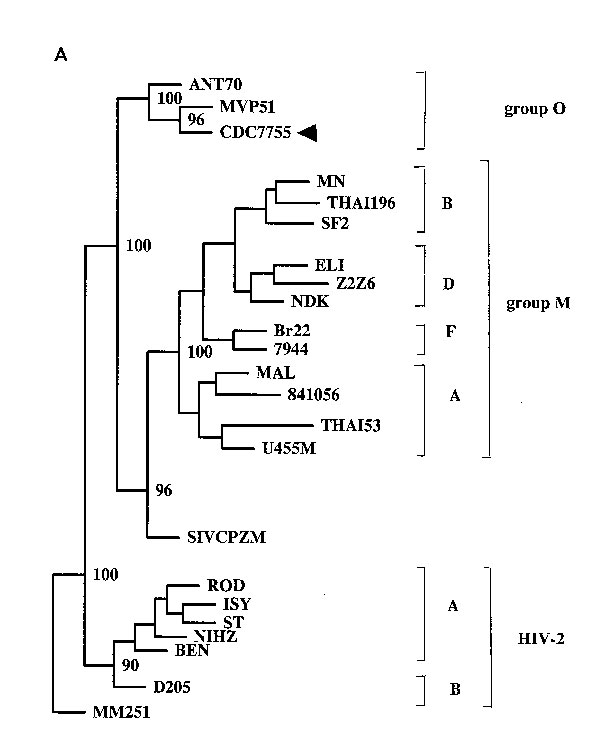Volume 2, Number 3—July 1996
Dispatch
HIV-1 Group O Virus Identified for the First Time in the United States
Figure 1

Figure 1. Phylogenetic analysis of the prt and env gene sequences. The patient's isolate is indicated by the arrow. The trees were constructed on the basis of the proviral DNA sequences for the protease gene (A) by the neighbor-joining method in the Phylip 3.5c package (2) and 230 aligned nucleotides from the C2V3 region of the env gene of Group O isolates (B) by using the maximum likelihood method with the fast DNAml program (1). Numbers at the branch nodes within the protease tree indicate bootstrap values. The SIV-MM251 protease gene sequence and the SIV-CPZ env sequence were used as outgroups in trees A and B, respectively. The nucleotide sequence distance among strains can be deduced from the horizontal branch lengths by using the included bar scale. Vertical distances are for clarity only.
References
- Loussert-Ajaka I, Chaix M, Korber B, . Variablility of human immundeficiency virus type 1 roup O strains isolated from Cameroonian patients living in France. J Virol. 1995;69:5640–9.PubMedGoogle Scholar
- Myers G, Korber B, Wain-Hobson S, Smith R, Pavlakis G, eds. Human retroviruses and AIDS 1994: a compilation and analysis of nucleic acid and amino acid sequences. Los Alamos, NM: Los Alamos National Laboratory, 1993.
- Brodine SK, Mascola JR, Weiss PJ, Detection of diverse HIV-1 genetic subtypes in the USA. Lancet. 1995;346:1198–9. DOIPubMedGoogle Scholar
- Schable C, Zekeng L, Pau CP, Sensitivity of United States HIV antibody tests for detection of HIV-1 Group O infections. Lancet. 1994;344:1333–4. DOIPubMedGoogle Scholar
- Identification of HIV-1 Group O Infection — Los Angeles County, California, 1996. MMWR. 1996;45:561–5.PubMedGoogle Scholar
- Pau CP, Hu DJ, Spruill C, Surveillance for human immunodeficiency virus type 1 group O infections in the United States. Transfusion. 1996;36:398–400. DOIPubMedGoogle Scholar
- Bandea C, Ramos A, Pieniazek D, . Epidemiologic and evolutionary relationships between Romanian and Brazilian HIV-1 subtype F strains. Emerg Infect Dis. 1995;1:91–3. DOIPubMedGoogle Scholar
- Pieniazek D, Janini LM, Ramos A, . HIV-1 patients may harbor viruses of different phylogentic subtypes: implications for the evolution of the HIV/AIDS pandemic. Emerg Infect Dis. 1995;1:86–8. DOIPubMedGoogle Scholar
- Gao F, Yue L, Robertson DL, . Genetic diversity of human immunodeficiency virus type 2: evidence for distinct sequence subtypes with differences in virus biology. J Virol. 1994;68:7433–47.PubMedGoogle Scholar
- Larsen N, Olsen GJ, Maidak BN, . The ribosomal database project. Nucleic Acids Res. 1993;21:3021–3. DOIPubMedGoogle Scholar
- Felsenstein J. PHYLIP-phylogeny inference package (version 3.2). Cladistics. 1989;5:164–6.
1Primers: gag/outer/forward - AGTACATGTTAAAACATGTAGTATGGGC; gag/outer/ reversed - CCTACTCCCTGACAGGCCGT CAGCATTTCTTC; gag/inner/forward - AGTACATGTTAAAACATGTAGTATGGGC; gag/inner/reverse - CCTTAAGCTTTTGT AGAATCTATCTACATA; protease/outer/forward - TTTGCCTCCCTCAAATC; protease/outer/reverse - TTACTGGCACTG GGGCTATGG; protease/inner/ forward - CCTCAAATCCCTCTTTG; protease/inner/reverse - TATAGGGAAGTTTAGTGTACA; env/outer/forward - CACAGAATTTAATGGAACAGGC; env/outer/reverse - TGTGTT ACAATAAAAGAATTCTCC; env/inner/forward - GTTACTTGTACACATGGCAT; and env/inner/reverse - AGAATTCTCCATGACAGTTAAA.